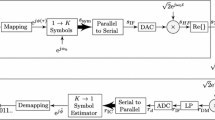Abstract
Many Ad-hoc networks for military and public safety environments are characterized by: large number of nodes in the same area (that means that frequency spatial reuse is less applicable), crucial situation awareness (which implies periodically frequent location updates, mission status, etc.), or high propagation delay (for example, acoustic or airborne networks). In order to support such networks, an efficient medium access control broadcast protocol is essential. Obviously, using one shared channel with only one packet reception at a time is not scalable and therefore multi-packet reception techniques are more suitable. Recent technological developments (patent pending) enable nodes to receive messages simultaneously in many, even hundreds of channels. In this paper we study the impact of the new multi packet reception capabilities. In order to compute close upper and lower bounds on the maximum delay, we consider the best scenario that is, the simple case of full mesh. We then propose algorithms that achieve a close to the best possible maximum delay between updates over all pairs of nodes. This is done by providing close upper and lower bounds on the maximum delay and giving simple algorithms that meet the upper bound. For theoretical completeness we study bounds for all possible relations between the number of nodes and the number of channels.
Similar content being viewed by others
References
Bao, L., & Garcia-Luna-Aceves, J. (2003). Distributed dynamic channel access scheduling for ad hoc network. Journal of Parallel and Distributed Computing, 63, 3–14.
Cai, Z., & Lu, M. (2003). Topology-transparent time division multiple access broadcast scheduling in multihop packet radio networks. In IEEE Transactions on vehicular technology (Vol. 52, pp. 970–984).
Chlamtac, I., & Faago, A. (1994). An optimal channel access protocol with multiple reception capacity. Transactions on Computers, 43, 480–484.
Chuzhoy, J., & Khanna, S. (2009). An O(k 3 log n)-approximation algorithm for vertex-connectivity survivable network design. In FOCS (pp. 437–441).
Crichigno, J., Wu, M., & Shu, W. (2008). Protocols and architectures for channel assignment in wireless mesh networks. Ad Hoc Networks, 6, 1051–1077.
David, Y. (1996). A unifying dynamic distributed multichannel TDMA slot assignment protocol. In Military communications conference (Vol. 1, pp. 235–239).
den Heuvel-Romaszko, S. V., & Blondia, C. (2004). A survey of MAC protocols for ad hoc networks and IEEE 802.11. In Proceedings of the 4th National conference (pp. 23–33).
Endsley, M. R. (1995). Toward a theory of situation awareness in dynamic systems. Human Factors, 37, 32–64.
Garcia, C. R., Lehner, A., & Strang, T. (2008). Comb: Cell based orientation aware manet broadcast mac layer. In IEEE GLOBECOM (pp. 1–5).
Garcia-Luna-Aceves, J., Sadjadpour, H. R., & Wang, Z. (2007). Challenges: Towards truly scalable ad hoc network. In MobiCom 07.
Kumar, S., Raghavan, V. S., & Deng, J. (2006). Medium access control protocol for ad hoc wireless networks: A survey. Ad Hoc Networks, 4, 326–358.
Lans, H. (1996). Position indicating system. In patent number 5506587.
Sadjadpour, H., Wang, Z., & Garcia-Luna-Aceves, J. (2010). The capacity of wireless ad hoc networks with multi-packet reception. IEEE Transaction on Communications, 58, 600–610.
Shrader, B., & Giles, T. (2002). Scheduling and performance of multihop radio networks with multiuser detection. In Swedish workshop on wireless ad-hoc networks.
Stayton, G. T., Ybarra, K. W., & Troxel, J. R. (2003). Formation surveillance and collision avoidance. In Publication number: US Patent 2003/016159 A1.
Yu, J. Y., & Chong, P. H. (2005). A survey of clustering schemes for mobile ad hoc networks. IEEE Communication Surveys and Tutorials, 7, 32–48.
Author information
Authors and Affiliations
Corresponding author
Rights and permissions
About this article
Cite this article
Avadis, S., Lerner, A. & Nutov, Z. MMM: multi-channel TDMA with MPR capabilities for MANETs. Wireless Netw 19, 323–330 (2013). https://doi.org/10.1007/s11276-012-0468-6
Published:
Issue Date:
DOI: https://doi.org/10.1007/s11276-012-0468-6




